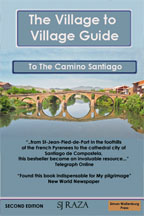28.
Lorca
(483m)(842)
Bar (a shy place almost afraid of advertising its presence- weekends only), fountain, rooms.
A pilgrim hospital served pilgrims and the local community in the thirteenth century. Impressed by its good works, Teobaldo 1, left the hospital a legacy in 1270. The church off Santa Maria with a Romanesque apse and Gothic nave was constructed in 1209. Some notable architectural elements were added in the sixteenth century.
A processional cloister was created beside the church in the flamboyant Gothic style of the fifteenth century. This is unlike that of the monastery of Monte Olivia in its configuration of space and decoration. The door of the church, beautifully designed and harmoniously proportioned, is plateresque. The renaissance-style tower, with a square base and an octagonal upper part, dates from the sixteenth century.
The choir stalls (1561) are most handsome. The Gothic painted panels of the altarpiece of the chapel of Eulate (XVI century) are very striking, excellently composed and coloured. This is particularly true of the two figures representing the Visitation. The main altarpiece and its wings are baroque and the polychrome wood figure of Santa Maria is fifteenth century gothic.
Directions:
Go through village past church (on your right) and down main street to road. Continue to top of hill. Turn left, then right along path boardered by cornfields and parallel to road. Follow track to village of Villatuerta.
|| INDEX OF VILLAGES|| PREVIOUS VILLAGE||
![]()
A SUMMARY OF A PAGE FROM The Village to Village Guide To The Camino Santiago: With Permission Simon Walleberg Press. The Book is available at Amazon & Most Bookshops.
@Copyright Simon Wallenberg Press
You will need the complete book if you wish to walk the camino in comfort: Even though you can depend on the information on these pages, but there is much more in the book Buy it if you can afford it,: Read Our Review of the above Book
||LEAD ARTICLE||THE CAMINO FAQ||BOOK LIST||ORDER FORM||DISTANCE CHART||
Telegraph Online Newspaper ©Telegraph Travel 2007

